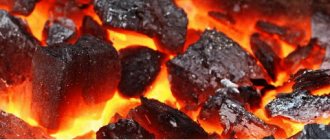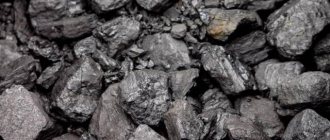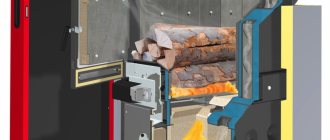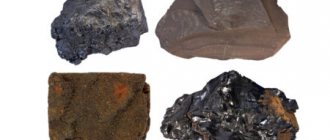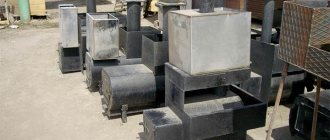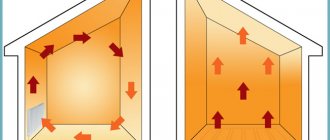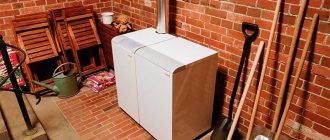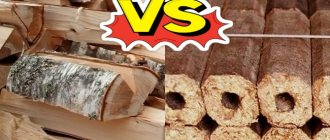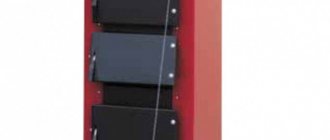The fact is obvious: a significant part of settlements or parts thereof were not affected by gasification. It is simply unprofitable to extend the highway to some areas. In addition, the built-up area of private houses and estates is constantly expanding, and the energy infrastructure does not always keep up with this growth rate. What to do if there is no gas, and heating with devices powered from the network is too expensive? Buy a solid fuel boiler and choose the right fuel for it.
Autonomy from any energy sources is the main advantage of solid fuel boilers. However, in order to make their operation efficient, it is necessary to take into account which type of fuel will be the least expensive.
The main rule when choosing solid fuel is its price at the nearest points of purchase, as well as the amount of delivery costs. More energy efficient types will lose all their appeal if they cost too much. And using cheap fuel will be unprofitable if it takes a lot of time and effort to deliver it.
There are several main types of products for solid fuel boilers, among which the owner must choose the most profitable to use.
Do you have a solid fuel boiler installed at your dacha?
Of course! No, but it will be!
Firewood
The very first type of fuel, which continues to be the most popular. Firewood is the name given to fragments of wood of a certain size intended for combustion in various devices to produce thermal energy. Most often they look like round parts of a whole trunk, but if the trees that serve as raw materials are thick, they are split into logs or logs in advance.
Firewood takes up the majority of the entire fuel market for privately owned boilers. They deserve such popular love due to a number of advantages:
Low cost . Russia is one of the countries rich in forest resources, so the price of firewood is low even in those regions where there is almost no natural forest or all of it has already been cut down. In settlements that are located near logging areas, the price is sometimes even lower due to minimal transportation costs and the opportunity to purchase fuel from the logger.- Environmental friendliness . Unlike oil, coal and gas, wood is a renewable natural resource. After a certain time, new trees fill the old clearings. With a competent approach to forestry, it is possible to achieve no loss of forest areas.
- Ease of storage and preparation . The only thing you need to protect firewood from is moisture. To do this, it is enough to construct simple sheds and properly store them in a woodpile. Firewood is unable to ignite on its own without extraneous heat sources, so fire safety requirements are no different from those accepted for the household as a whole.
- Undemanding to the boiler design . Wood burns in any device. To burn them, a simple potbelly stove connected to a water tank is enough. More complex designs have high efficiency when the heat received from the firewood is used as efficiently as possible.
Perhaps this fuel has only two disadvantages, although they are quite significant:
- Due to the size and structure of firewood, it has to be prepared manually for loading into boilers. Therefore, sawing and splitting are necessary preliminary procedures for operating a wood-fired boiler. In this regard, automatic supply of firewood is difficult.
- The heat generation of natural wood is less than that of competitive raw materials that have undergone processing stages. It's all about the high level of natural humidity. Part of the heat is spent on evaporation of the liquid.
To purchase the dryest firewood possible, try to buy wood in late winter or early spring. They will sell you a fresh cut, where the juice has gone as deep as possible. During the summer and autumn, this firewood must be aged, so that by the next heating season it will dry out properly.
The calorific value of ideally dry wood is about 5 kWh/kg. However, in real conditions, such an indicator can only be obtained in special drying ovens - such firewood is much more expensive. The calorific value of most hardwoods is 4.2 – 4.3 kWh/kg.
When choosing firewood as fuel, it is worth remembering the following:
- Hardwood firewood burns better than coniferous wood. This occurs due to the greater amount of moisture in pine and spruce logs. But coniferous logs are easier to split into logs.
- Beech and oak are well suited for long-burning boilers as they emit little soot and contain little moisture. However, they are difficult to split.
- When firing a boiler with wood, it will require regular – at least once a year before the heating season – cleaning of soot and soot, which impair heat transfer.
- The “hottest” firewood is dry birch, as well as white acacia, common in the south.
Operating principle of solid fuel boilers
Solid fuel boilers that are on sale today are mostly all equipped with control systems and fans that supply air to the combustion chamber. The control unit consists of a temperature sensor installed on the heat exchanger. Signals about a decrease or increase in coolant temperature cause the automation to operate, which turns the air blower on or off. As a result, the automation itself exercises control over the temperature regime, regulating the intensity of combustion.
Heating boilers using automation reduces human participation to a minimum. After fuel is loaded, all operation of the apparatus is controlled by automatic devices and mechanical devices. The device, having reached the optimal operating mode, goes into smoldering mode. As the temperature decreases and the combustion intensity weakens, the pressurization system is turned on again. The process is monotonous and constant, thanks to which air is supplied to the combustion chamber and the exit of combustion products through the chimney is improved.
If the fuel in the firebox runs out, the automation uses the coolant collected in the heat accumulator. This scheme prevents the heating system from cooling quickly and reducing the coolant temperature to critical values. In some cases, the autonomous heating system is supplemented with an electric boiler - a heating element, which serves as a backup heat source when the main heating unit is stopped.
Important! Controlling the amount of fuel added to the boiler is a task that still needs to be controlled by a person. Knowing the power of the device and the needs of the heating system, you can calculate the number of fuel fills. Automation is only capable of maintaining the entire system in working condition for a short time, protecting the equipment from overheating and from complete shutdown.
*
The operating principle of solid fuel boilers is simple and clear. Proper piping allows not only to create normal conditions for the operation of the heating device, but also ensures the uninterrupted operation of the entire heating system in the house.
Pellets
Pellet boilers are one of the most advanced solid fuel systems.
Pellets are small fuel granules that look like oblong cylinders 2–4 cm in length and about 7 mm in thickness. The raw materials for their production are waste from wood production: sawdust, wood chips, bark, as well as substandard wood, which is unsuitable for other purposes.
Expert opinion
Torsunov Pavel Maksimovich
Depending on the proximity of waste sources, pellets may also include agricultural waste - husks, dried stems, husks. Sometimes peat or coal chips are added to pellets, which increases their calorific value.
Pellets are produced by drying and pressing. When the mixture is subjected to pressure, the temperature inside it increases, lignin, a component of wood, is released, which firmly glues the particles together.
Torrefied fuel pellets are considered the most valuable fuel. They burn without oxygen, acquiring a dark color. Due to this, their heat capacity increases. In addition, they are not afraid of moisture and do not crumble over time.
Pellets have a number of advantages:
Environmental friendliness and production using waste-free technology . Pellets are made not just from wood, but from production waste, which otherwise would go to a landfill or recycling incineration. The use of agricultural by-products, which are regarded as nothing more than garbage, makes pellets one of the most progressive types of solid biofuels.- High combustion efficiency . Thanks to the production technology, pellets contain a small amount of moisture - only 8 - 12%, while naturally dried wood will still contain 25 - 30%, and fresh wood - 50% or more water. Burning pellets produces approximately twice as much heat as burning wood. If we compare the calorific value with hydrocarbons, it is only two times less than when burning fuel oil or gas.
- Low ash content . Pellets are practically devoid of the main drawback of wood - they form a small amount of non-combustible residues, and the content of soot and soot in the smoke is reduced. The share of ash in the granules is only 3%, so boilers and chimneys when using them require less frequent cleaning.
- Good transportability . Due to relatively high mechanical strength, small size and high density, pellets are light and easy to transport. At production, they are packaged in various containers weighing up to one ton in big bags and can be delivered by any type of transport.
- Possibility of automated feeding . Due to the identical sizes of small granules, they can be fed into the boiler automatically, using special dispensers, Archimedes screws and other devices. This allows the solid fuel boiler to be endowed with a high degree of autonomy.
Unfortunately, pellets have two significant disadvantages:
- The high cost, which arises from production costs: drying, pressing, firing. Therefore, compared to other wood fuels, the cost of pellets will always be higher.
- Enterprises that produce fuel pellets are not located in all areas. Buying pellets with delivery over long distances can completely negate their economic advantages.
Pellets are most widespread in European countries, where environmental fuel is in greatest demand. The possibility of useful recycling of waste, coupled with high energy efficiency, makes it the number one solid fuel, especially since there are almost no large forest areas allowed for felling in Europe.
Instructions for firing the stove
Algorithm of actions:
- Place crumpled pieces of paper and thin wood chips in the grate area. You can put 1-2 small logs.
- Open the ash pan door by ¼ and the chimney valve by ½.
- Set the paper on fire using matches. After the fire has started, you should increase the amount of air supplied by opening the vent by ½.
- After the entire paper-wood structure has ignited, gradually add more wood as it burns out.
- Re-laying of firewood must be done when large coals have formed (about half an hour after the first laying).
- The combustion process is controlled by a valve and a blower.
A very important indicator that you need to pay attention to is the color of the flame. The color of the straw indicates a normal combustion process. If the flame has changed color and turned white, and you hear a strong hum in the outlet channels, then this is a sign of increased draft, you need to cover the ash pit. Red flames and black smoke from the chimney are indicators of insufficient draft; the vent needs to be opened slightly.
Video: how to light a brick oven with your own hands
How to drown in black
Special mention should be made of the nuances of firing a stove in black, although such devices are no longer as common as in past centuries. In modern times, baths are mainly heated in this way: the efficiency in this case is very high, much higher than in “white” baths. Little fuel is required for good heating.
Combustion products in such structures do not exit through the chimney, but through the windows and door. A lot of soot settles on the walls, but you should not be disdainful, since in this situation it acts as an adsorbent.
Procedure for black stoves (in the bath):
- Open the windows and door to bring in fresh air and maintain the combustion process.
- Stack the firewood in a “house”, placing scraps of paper under it and set it on fire.
- Before laying firewood for the second time, it is necessary to spill water on the walls and shelves.
- Gradually add firewood, finishing the fire when crimson light appears above the stones.
- It is necessary to wait until the last portion of firewood burns out and remove the coals remaining after that.
- Ventilate the room by opening the windows and door.
- Rinse doors and shelves with cold water.
- Splash a tub of water on the heater and close the doors.
First fire of the new furnace
If the stove is just folded and everything is ready for kindling, then remember a few useful rules.
Firstly, take your time and let the masonry dry. This may take 2–3 days. Light the stove, following all fire safety rules, and see if there is any smoke. Then touch the stove in different places, it should warm up evenly, without temperature changes. Also, the stove, folded correctly, should cool to the same extent.
Secondly, test the quality of the masonry. The density of the laid brick should not allow smoke to pass through. For this test, burn synthetic materials that smoke heavily in the firebox and see if smoke escapes.
If everything went well, the oven can be used!
You may find this material useful on how to properly build a brick oven yourself:.
Fire up the stove after a long period of inactivity
After winter, when you arrive at your dacha, you will want to warm up and light the stove. This must be done in such a way as not to cause damage to either the stove or the residential or bathhouse building itself.
First of all, you need to inspect the oven from the outside and inside to detect:
- cracks;
- chips;
- foreign objects;
- small animals and birds;
- excess soot.
All this can become an obstacle to the normal operation of the furnace. Chips and cracks must be eliminated by sealing them with mortar, and foreign objects must be removed. To clean the chimney of soot, you can use a special metal ball on a long rope. The ball, which is often equipped with a wire brush, is lowered “down the shaft” and raised up, repeating these manipulations several times, shaking off the soot after each rise.
A mandatory action before heating the stove after a long break is checking the draft. Firewood is set on fire with all doors open (ash pan, ash pit, fire door), then they are closed, adjusting the degree of exhaust.
Sometimes the lack of draft can be due to a large amount of cold air in the chimney. Therefore, heating the chimney part of the stove will help eliminate this problem.
We lay two logs parallel to each other at some distance, then place the other two on top of them, placing them perpendicular to the first row. It looks like a mini-well, inside which you need to place paper, a piece of birch bark and splinters.
A stove that has not been fired for a long time cannot be used at full capacity right away; try to ensure that the heating process is gradual, starting with short time intervals.
Proper fuel stowage
People who are far from the firebox of a stove may be surprised to learn that proper placement of fuel can affect the operation of this device.
The most commonly used methods for stacking firewood are:
- horizontal (rows of firewood follow each other with uniform distances between them);
- conical (they build something like a hut from logs);
- diagonal (the first log is laid diagonally in the firebox, all others - at an angle to it).
This is what one of the options for stacking firewood in the stove looks like
The firebox should not be filled to capacity; approximately a fifth should remain free.
When using coal, kindling is done with wood, then, when the fire flares up, a layer of coal is poured (about six centimeters). The height of subsequent layers can reach up to fifteen centimeters, but the coals must allow air to pass through well. It is advisable to stir the coals periodically using a poker or other special devices.
Warm up in the cold (including in winter)
The cold season, especially winter, requires more frequent use of the stove. When trying to warm the room as much as possible, you should not heat the stove too often or too much, as you can cause it to overheat. An overheated stove can collapse faster, the brickwork begins to crumble, burnouts appear in the channels, etc.
Therefore, heating in the winter season needs to be done wisely: heat the stove moderately, twice a day is enough. If you want to “add up the heat,” then conduct each subsequent fire at intervals of at least four hours.
Fuel briquettes
In its composition, this type of fuel is similar to pellets, but looks somewhat different: briquettes are larger and can be not only cylindrical, but also of any other regular shape. The starting raw materials are the same wood chips, sawdust, and shavings. Organic residues of plant crops grown in agriculture are also widely used.
Some types of fuel briquettes are made exclusively from dry pine needles. Perhaps this is the only option for their useful use
Fuel briquettes have the same advantages and disadvantages as pellets. The main difference still comes from the size: briquettes are not suitable for automatic loading, so they are placed in the firebox manually. Products with an aesthetic appearance have gained popularity among owners of fireplaces and decorative stoves due to the almost complete absence of smoke during combustion.
Fuel briquettes are produced in various standards:
Pini-kay
Although the company with a similar name has already closed, the introduced technology is thriving. The briquettes are dark in color and have a hexagonal shape with a central channel. Pressure during molding – up to 1100 bar + exposure to high temperature. Best characteristics and high price.
RUF
Popularly known as “bricks”. These briquettes are indeed made in the form of small parallelepipeds. Formed at pressures up to 300 bar.
Cylindrical shape
Sometimes with a longitudinal hole. Working pressure – up to 600 bar.
Conditions and rules for fuel storage
Each type of raw material has its own characteristics. Coal and peat are placed in a warehouse only after a 2-week stay in the open air, with 2- or 3-fold mixing. Firewood is dried and stored in stacks, and is treated with antiseptics and insecticides.
Pellets and briquettes initially have low humidity, but can absorb it from the environment. They require a dry place to store them.
Such fuel is placed on pallets to provide air access from all sides. Most of these products come in sealed bags, but there is always a risk of damage.
Coal
Among various types of solid fuel, coal has the greatest heat transfer, which makes it one of the most efficient energy carriers in heating boilers.
The amount of heat released during the combustion of coal is twice as high as that for wood and is about 7.5 kWh/kg. Thus, to maintain a certain temperature of the coolant in the circuit, coal will require significantly less than other types of solid fuel.
The most efficient in terms of heat production is anthracite. It contains a minimum of moisture and impurities. However, it is very expensive and burns quickly, giving a very high temperature, which is simply not needed in heating boilers.
The advantages of coal are due to its physical and chemical properties:
- High calorific value . The main plus. With proper boiler design, a bucket of coal may well last for a day. The volume of fuel reserves purchased for the heating season is smaller, this is especially beneficial for small or densely built-up areas.
- Coal is not afraid of moisture . Although coal pits and sheds are built for storing coal, the inside of them does not need to be as dry as possible. When wet, coal retains its properties when it dries, since moisture does not penetrate inside.
- When burned, coal produces a very high temperature , which wood and its derivatives cannot produce. This allows the coolant in the circuit to be heated more efficiently with less fuel.
Unfortunately, coal is quite expensive. Even taking into account the fact that it produces more heat, there may not be any economic benefit from its use. Another thing is the location near famous coal basins. In these regions, coal is always cheaper and much easier to buy. In places of deposits, coal almost completely replaces firewood from use.
Fire safety! When dumping coal into large piles, there is a danger of spontaneous combustion. The fact is that a mineral extracted from the bowels of the earth oxidizes in the air, which leads to self-heating. When the critical point is reached, the coal ignites inside the heap - slow burning occurs.
To prevent self-ignition, coal is stored on a non-combustible substrate and poured in layers. You should also be careful when firing a boiler with coking coal, which is sometimes purchased by owners of plots located near enrichment plants. If used incorrectly, coke can produce such a high temperature that a steel and even cast iron furnace burns through, rendering the boiler inoperable.
What are the dangers of using unsorted coal?
The use of this type of fuel in TKDG can lead to equipment failure. Unsorted coal contains a lot of dust, and its combustion efficiency is low.
In addition, large pieces are often found. When using automatic fuel supply, their entry into the mechanism leads to jamming and breakdown.
In our country, sorted coal is rarely sold, and it is expensive. Therefore, for boilers operating on solid fuel, it is better to buy “seeds” - the fraction of such a product is 6-13 mm.
Most often it is anthracite, but it has a high calorific value and combustion temperature, as a result of which equipment often fails.
The use of fine coal in TKDG will lead to the following results:
- the fuel is not burned out, it will have to be sifted and reused;
- the rated power is reduced (for example, in the technical characteristics of the equipment it is 25 kW, but the unit will be able to generate no more than 15 kW).
Which coal is best for a solid fuel boiler? For efficient operation of a unit with automatic feeding, it is recommended to use long-flame coal. In Russia, such raw materials are produced with a fraction of 13-50 mm, while for this equipment it is allowed that the size of individual pieces does not exceed 30 mm.
Brown coal
Brown coal has always belonged to the lower class of solid fuel. It is used quite rarely in industry due to its low calorific value. It is usually less than that of dry wood and approximately corresponds to 3.5 kWh/kg. The main trump card of brown coal remains its low price. However, even under this condition, the choice of brown coal as a fuel for the boiler is justified only in those places where the corresponding deposits and processing plants are located.
Heat transfer table of all types
The energy efficiency of the listed fuel types differs. Even the same type of raw material, under changed production and storage conditions, will have different heat transfer rates. For comparison, average values are taken (see table).
| Type of fuel | Humidity, % | Calorie content, kcal/kg |
| Firewood | 20-25 | 2800-3400 |
| Coal | 12-18 | 6500-7000 |
| Brown coal | 14-22 | 3100-3600 |
| Peat | 28-30 | 2600-2800 |
| Pellets and briquettes | 6-10 | 4300-4700 |
The heating device is the warmth in the house
Many settlements today have not yet been gasified. Therefore, residents of such villages have to look for an alternative to gas equipment. The best solution in this case is to heat a country or private house with a solid fuel boiler.
It is becoming increasingly popular not only due to its ability to work on wood or coal, but also due to its complete autonomy.
After all, a solid fuel boiler does not require either gas or electricity. It can only operate on wood, while maintaining a comfortable room temperature. However, such devices are available in various modifications, and in order to make the right choice, you need to at least briefly get to know each of them.
Two important conclusions
1. Different ash content
Two samples of straw briquettes have different ash contents - 4.86 and 7.3%.
Ash is mineral substances in wood that either have little energy value or simply do not burn. Therefore, the more ash in the wood, the less its heat transfer.
Different ash contents of fuel briquettes indicate different quality of production and source materials. One manufacturer does not clean the straw well enough to remove dirt and external ash. Another is adding foliage and other materials for volume. At the output, this greatly affects the quality, calorific value and burning time of the fuel briquette. And this situation can happen with any briquettes, not just straw.
2. Different humidity
The moisture content of the briquettes and their seed husks is 2.7% in one case, and 8.51% in the other. Some sawdust briquettes have a moisture content of 4.1%, while others have a moisture content of 10.3%.
This means that the humidity of fuel briquettes is also different. Their strength and calorific value depend on this: at a humidity of 4.1%, the heat transfer of a briquette is 5043 kcal/kg, and at 10% — 4341 kcal/kg.
Solid, liquid or gas?
Mini-boiler room diagram
Upon careful consideration (for which, unfortunately, there is no room here), in terms of the totality of qualities, natural gas and liquid fuels so far turn out to be the best. But it’s better not to try to make a stove for them yourself: without industrial equipment and well-established technology, even an experienced heating engineer will not undertake this. More precisely, he won’t take it on, knowing what’s what.
And there is a nuance: since this fuel gives off heat almost instantly, you can’t get by with just one stove. Combustion also requires a complex set of equipment. For an example, see Fig. scheme of a house mini-boiler room. This costs a lot, and it turns out to be economically (and environmentally) justified for households with a living area of more than 120-150 square meters. m.
Note: The efficiency of even a small gas or oil boiler with automation reaches 90% or more. Almost all losses in centralized boiler houses occur in pipelines.
A homemade stove can heat and supply hot water up to 60-100 square meters. m. residential. More - the complexity of the work and costs increase so much that it turns out to be cheaper and easier to install a double-circuit gas boiler. If, of course, there is a gas supply. In this case, you need to focus on the lowest of the indicated values; with bottled gas – to the highest level.
An exception is a pyrolysis (more precisely, gas generator) furnace using waste or dark heating oil. It is easy to do it yourself, subject to safety conditions. But the heated area is up to 40-60 square meters. m, heat extraction for hot water supply is difficult, and the installation of a full-flow water heating circuit is hardly possible. Those. scope of application: garage, cottage, small residential building, provided that the stove is in an extension.
Note: Pyrolysis oil is not a fuel for pyrolysis furnaces. It is a product of rapid (50-30 s) oxygen-free pyrolysis of wood waste at a temperature of about 600 degrees. Pyrolysis oil is quite heavily watered and has an acidic reaction, i.e. chemically aggressive components in its composition and contains up to 2% or more sulfur. It is burned in industrial boilers and furnaces using a special burner.
